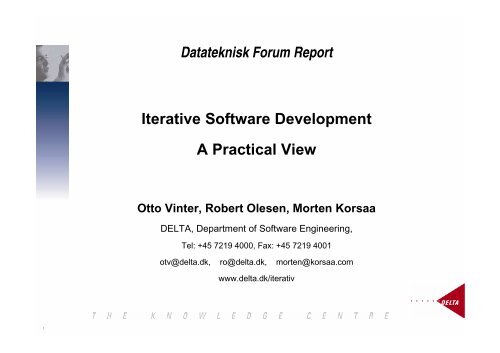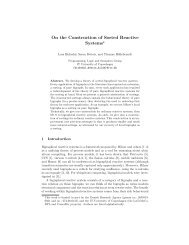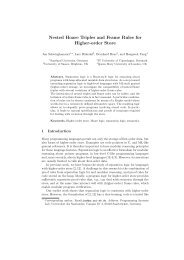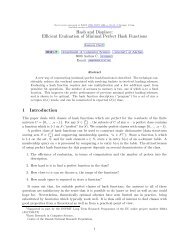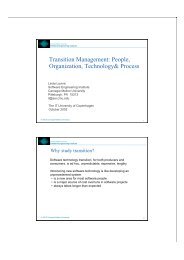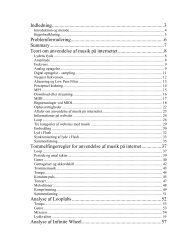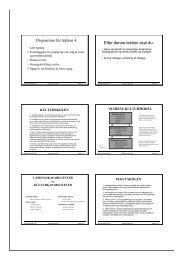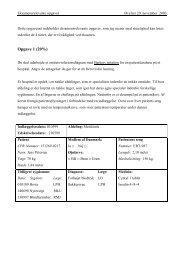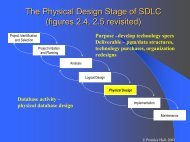Iterative Software Development A Practical View
Iterative Software Development A Practical View
Iterative Software Development A Practical View
You also want an ePaper? Increase the reach of your titles
YUMPU automatically turns print PDFs into web optimized ePapers that Google loves.
Datateknisk Forum Report<strong>Iterative</strong> <strong>Software</strong> <strong>Development</strong>A <strong>Practical</strong> <strong>View</strong>Otto Vinter, Robert Olesen, Morten KorsaaDELTA, Department of <strong>Software</strong> Engineering,Tel: +45 7219 4000, Fax: +45 7219 4001otv@delta.dk, ro@delta.dk, morten@korsaa.comwww.delta.dk/iterativ1
Content• Background• Overview of the Report• Principles for <strong>Iterative</strong> <strong>Software</strong> <strong>Development</strong>• Related aspects• Implementation2
What is it? It is a solution to a problem!Risk:The quality of the available information is insufficient!Handle the risk!Waterfallplanning, andsolving problemsas they occur.Eliminate the risk!<strong>Iterative</strong> planning.3
Waterfall Model Example - The V ModelRequirementSpecificationTest specificationsAccept testHigh leveldesignIntegrationtestDetaileddesignModule testBuild on sequential stages andfully elaborated documents asstage completion criteriaCoding4
<strong>Iterative</strong> Model Example - RAD ModelProject Project Setup Setup10 daysPreliminary Interviewsand and RAD RAD workshop20 daysInitiateDevelopIteration N<strong>Iterative</strong> Design and Build100 daysEvaluateIteration NDevelopBuild onincrementalreleases, userparticipation,frequent feedback,and changeanother iterationReview, Review, Rebuild Rebuild Implementationand and ImplementReview Review20 daysDeploy5
Waterfall <strong>Iterative</strong>Assumptions• The customer knows what hewants• The requirements are frozen(changes are exceptions).• Phase reviews are used ascontrol and feedback pointsCharacteristics of success• Stable requirements• Stable environments• Focus is on the big picture• One, monolithic deliveryAssumptions• The customer cannot expressexactly what he wants• The requirements will change.• Reviews are done continuouslyfor control and feedbackCharacteristics of success• Fast and continuous userfeedback• Floating targets• Focus is on the most importantfeatures• Frequent releases6
Purpose of the report• Understand and evaluate if iterative development willsupport your business.• Choose among the most common iterative developmentmethods the one that is most suitable for you.Audience• Primarily developers, project managers, and linemanagers in development.• Secondarily method/architecture groups andprocess/quality departments.7
Metaphor: A Traveller’s Guide• Introduction to the area• The history• The people and the culture• Tours in the area• Description of places and sights• <strong>Practical</strong> hints and tips• Commonly used phrases• References to more information8
A Guide to <strong>Iterative</strong> <strong>Development</strong>• Introduction• The history• Its purpose• Principles• Methods• Related activities• Experiences• Referenceswhat is itwhere does it come fromwhy, when, and how to use itwhat are the characteristicswhat frameworks existwhat is important to knowwhat have others donewhere to find more detail9
The Principles• We have derived some principles for <strong>Iterative</strong> <strong>Software</strong><strong>Development</strong> to guide the implementation.• They can be used to judge if a given practice is iterative.Then you can assess whether the practice is supportingyour business, or it need to be changed.• Use them literally every time you are discussing apractice. The principles may not be the final truth, but ifyou use them to guide a discussion, you will end with aconclusion of what is true for you. And that is the mostimportant.10
Principles of <strong>Iterative</strong> <strong>Development</strong>• Time has priority over functionality• Get the most bang for the buck• Power to the customer• Empowered teams• Adaptability• Short life cycles• Fast feedback11
“Time has Priority over Functionality”• Time– Fixed- by all means• ResourcesTimeboxingTime– In reality fixed• Functionality– The only variableResourcesFunctionalityYou can’t stop the clock!12
“Get Most Bang for the Buck”• First things first– Do what is the most important first.Things that matter the mostmust never be at the mercy of thingswhich matters least.Goethe13
“Power to the Customer”• Responsibility– <strong>Software</strong> development people– Customer• PrioritisationThe customer is always right– Feature– Architecture14
“Empowered Teams”• Decision Speed• Competencies must bepresent.A little practice beats a lot ofsteering committee meetings15
“Adaptability”• Learning– Evolution / Definition– Ability to change– A specification may act as a learning obstacleIf the map and the landscape disagree,trust the landscape!Winston Churchill16
“Short Life Cycles”• Experience capability– When you have integrated the almost completesystem 10 times, integrating the complete system isno big deal.• Risk management– The faster you bring your stuff to the target, the moreyou will learn about the full life cycle.Deal with small problemsbefore they become big.17
“Fast Feedback”• Risk management– The sooner your customer see the product, thesmaller mistakes are you able to make.• At all levels– developer– feature– system– productIt is better to light a candle,than to curse the dark.18
Aspects Related to <strong>Iterative</strong> <strong>Development</strong>• Iteration• Continuous Integration• Configuration Management• Requirements Management• Project Management• Test• Myths and Obstacles• Legal Perspective19
Initiation <strong>Development</strong> Deployment”The <strong>Iterative</strong> Life Cycle”PhasePhaseIter.PhaseIter.PhaseReleasePhase-based Life Cycle ModelIteration Iteration Iteration ReleaseIteration-based Life Cycle Model20
”Continuous Integration”• Personal level– Features• Project level– Daily builds• Product level– Releases21
”Configuration Management”• Even more important than in waterfall development– Change Management– Continuous Integration– Frequent Releases– Build Management22
”Requirements Management”• Elicitation– An ongoing process– No need for a complete and detailed requirementspecification at start• Prioritisation– For the next iteration• Measurements• Very different from Waterfall projects23
”Project Management”• From Waterfall to <strong>Iterative</strong>:– From manager to coach.– From "keeping the team on track" to "enabling theteam to shape the track”– From managing detailed activities to manage initerations– From "one time planner" to "continuous re-planner"24
”Test”An ongoing process, not one shot at the end• Testing in Feature <strong>Development</strong> Iterations– Peer reviews– Feature tests– Test automation• Testing in Clean-up and Reorganising Iterations– Test reorganisation– Regression test• Testing in Release Iterations– Similar to waterfall project25
”Legal Perspective”Contract TypesAdvice to the Customer• Total Delivery (K18/K33)• Delivery in Phases• Time and Material Contractsand• Combinations• Define if ISD will be beneficialin the actual case• Are you willing to accept therisk of loss of investment?• Establish communicationchannels in the contract• Operate in short periods (2-4weeks) to minimise risk• Formalise renegotiations in thecontract• Ownership26
Quality and Maturity Models• ISO 9000• CMM• Bootstrap• SPICE27
<strong>Iterative</strong> <strong>Development</strong> Methods• Dynamic Systems <strong>Development</strong> Method – DSDM• DSDM Consortium - www.dsdm.org• Microsoft Solutions Framework - MSF• www.microsoft.com/business/services/mcmsf.asp• Rational Unified Process – RUP (Booch e.a.)• www.rational.com/products/rup• eXtreme Programming – XP (Bech e.a.)• http://c2.com/cgi/wiki?ExtremeProgramming28
29“RUP - Rational Unified Process”
30“DSDM - Dynamic Systems <strong>Development</strong> Method”
“MSF - Microsoft Solutions Framework”• Roles and responsibilitiesProgramManagementProductManagement<strong>Development</strong>UserEducationTestingLogisticsManagement31
“XP - eXtreme Programming”XP Values• Communication• Simplicity• Feedback• CourageXP Principles• Planning game• Small releases• Metaphor• Simple design• Testing• Refactoring• Pair programming• Collective ownership• Continuous integration• 40-hour week• On-site customer• Coding standards32
Experiences - Cases Studies• XP @ BANKDATA• A MSF Case Study from Navision• Unibank• Introducing RAD at the Danish State Archives• Implementing an <strong>Iterative</strong> <strong>Development</strong> Process atTellabs• <strong>Iterative</strong> <strong>Development</strong> at Brüel & Kjærand• How this report was written33
Myths and Obstacles• Standard contracts• Hierarchical organisations• Mission critical software• Large projects / Scalability• No direct customer• “You never know what you get”• “ISD is hacking without a plan”34
<strong>Iterative</strong> <strong>Software</strong> <strong>Development</strong> – A <strong>Practical</strong> <strong>View</strong>www.delta.dk/iterativ:• Forkortet udgave af rapporten• Spørgeskema om iterativ udvikling i praksisPris:• Medlemmer af Datateknisk Forum kr 200• Andre kr 800Kontakt: Karin Macko, DELTATel: 7219 4244, Fax: 7219 4001, email: km@delta.dk35
Datateknisk ForumERFA gruppe 25: eXtreme ProgrammingP.t. 29 medlemsvirksomhederMødefrekvens ca. hver anden månedNæste møde 4. JuniMedlemskab: kr 7.500 (DTF) + kr 1.500 (ERFA gruppen)Ang. medlemskab kontakt: Karin Macko, DELTATel: 7219 4244, Fax: 7219 4001, email: km@delta.dk36


